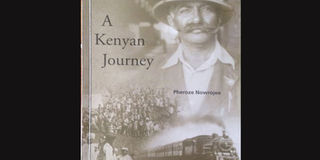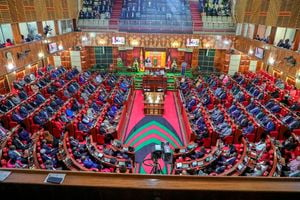How 1910 train ride to Makindu changed my family’s destiny

The cover of Pheroze Nowrojee’s book 'A Kenyan Journey'. PHOTO | WILLIAM OERI | NATION MEDIA GROUP
What you need to know:
With the standard gauge railway now operational, writer and lawyer Pheroze Nowrojee remembers the old railway, whose construction brought his family from India to Kenya.
He describes a ride that shaped his family and how it helped them find a home.
With the standard gauge railway now operational, writer and lawyer Pheroze Nowrojee remembers the old railway, whose construction brought his family from India to Kenya. He describes a ride that shaped his family and how it helped them find a home.
Rides on the old railway were significant moments in the lives of many generations of Kenyans. Indeed, the rides shaped many destinies, including mine.
My family arrived in Kenya in April 1896. My grandfather, Pheroze Nowrojee, after whom I am named, was an engine driver. This was his train ride, made in 1910, and it shaped the destiny of my family.
Through a brief plume of steam, his locomotive whistle blew out, echoing farther and farther into the night. Leaning out, Pheroze looked backwards for the faint green beam of the guard’s signal lamp. He found it through the steam surging around him, the long ill-lit platform and the faint mist of the cold night in Voi.
The carriages, protesting the increased pull, gathered speed as the train moved out of Voi station.
The dark frame of the Taita Hills rode alongside him, containing the long plain on his left. Waves of wind rushed in and sprays of red earth flew across the cab. Dust flooded in, mixing into the sparks, the gray ash, the smoke and the wet steam already there. His iron machine, the first ever competitor to the wind for speed on these plains.
Over the roar of the locomotive, the constantly grating wheels and the quarrelling couplings, he could still hear the sounds of the night. His thoughts turned to the sounds he kept hearing in his quarters at Voi, where too, no night was mute. Sometimes he would shine a lamp up. But all he could see were his own village fears, the bigger shadows he thought he had left behind, of bubonic pains and emigration.
CLEARING APPEARED
The earth started rising and the engine slowed with the effort. Then suddenly, out of the night and the dark half-tunnels of the cuttings, the famous clearing appeared. This was Tsavo. Among the rocks and the shrubs and the nearby drop to the river, the coolies had made a small plain. Here had been the tents to which the man-eaters had come, picking their meals, not at random, but with malice aforethought. Twenty six coolies had been carried away by the lions. Now silence blew over the place, the wind long ago having carried away the forlorn cries of the victims and the loud terror of the survivors. The workers’ supervisor, Roshan Kadar Baksh, in his Urdu poem of it, later wrote:
“Here these lions fell on the workmen and destroyed them. Such was their habit, day and night, and hundreds of men fell victims to these savage creatures, whose very jaws were steeped in blood. Bones, flesh, skin and blood, they devoured all. And left not a trace behind them.”
Rain slanted over the line. The rain he had grown up with in India had felt different. Yet both the rains were the same Monsoon winds blowing from the same sea but in opposite directions, rather like himself and the other workers, blown in on the sea from India, rather than to India.
MAJOR STATION
A gathering of lights ahead told him that he was now entering one of the major stations. He moved to reduce speed, and as the brakes went on the platform lamps came into view, their glass gleaming, carrying the legend, Mtito Andei, 2,420ft.
This was a major halt, neither Coast nor highland, for the train to Nairobi had reached mid-journey. As the train moved towards Kibwezi, large shadows rose around the moving train, their arms seeming to follow after it, wanting to hold it back, pleading with it when it ignored them. He had never seen trees like these before, as barren of leaves as of fruit. Traversing the level crossing at which there was no light, and leaving those thick baobabs behind, he entered Kibwezi station.
As he neared his destination, Makindu, it was still night, but before dawn broke for him, he saw that the high mountain on his left had caught the light and, at its peak, day had already begun. The white summit of Kilimanjaro glowed pristine against a background that was neither night nor sky.
BALDWIN LOCOMOTIVES
He brought the large Baldwin locomotive into a Makindu of shadows, the station lights ineffective in the increasing light, and the day not yet pervasive.
Makindu, then, was a bustling halt. Past the railway houses, a short distance from the line, there was a small free standing room, where all the railway workers from the Punjab – Sikh, Hindu and Muslim – met in the evenings for prayers and to sing hymns. This would later be replaced by a Sikh Gurdwara. Pheroze dismounted and in the long halt, handed over to the new crew to take the train on to Nairobi.
This night Pheroze had travelled only a 100 miles from Voi, but from his beginnings in India, it was thousands. He had journeyed far from his birthplace. But he felt now that here in Kenya, he had finally found a home. And he never returned to India.
Pheroze Nowrojee is a writer, human rights and constitutional lawyer and poet. He is the author of 'A Kenyan Journey'.





